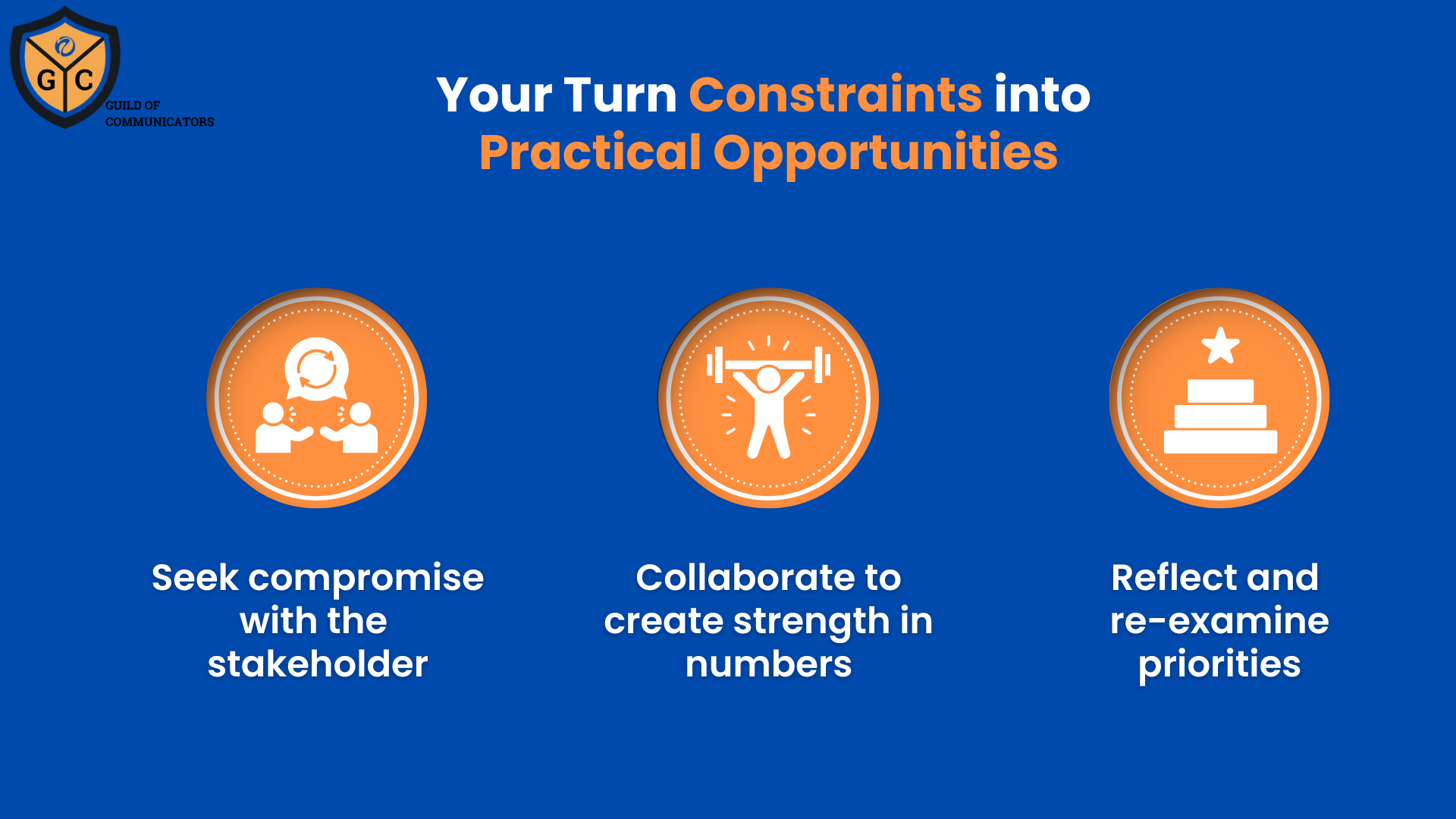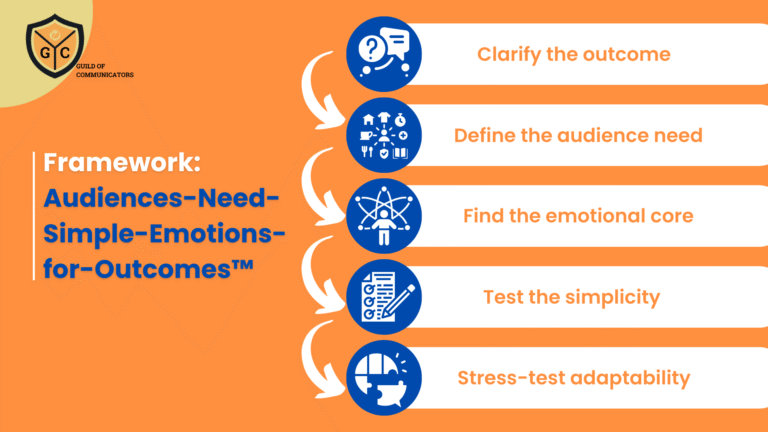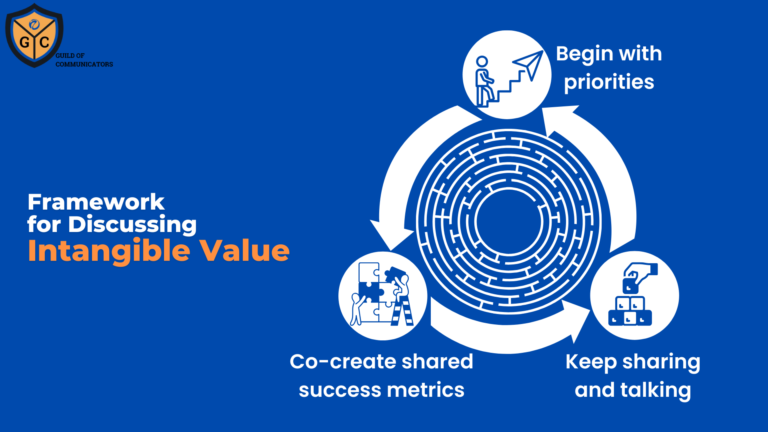Communicators carry a responsibility that extends beyond delivering campaigns or content. Our role is to secure alignment from stakeholders, build confidence in our organisation’s plans, and deliver outcomes that matter. This requires us to recognise that communication is not simply about execution. It is also about navigating decisions, compromises, and priorities that shape what gets done and how.
At the start of every planning cycle, there is optimism about what can be achieved. Plans are designed with ambition, and they often assume access to the resources needed. Yet, in practice, decisions about funding and support are rarely straightforward.
Communicators must be prepared not only to advocate for their plans but also to accept that adjustments are part of the process.
This means that our role is not only about defending ideas but also about demonstrating adaptability. When resources are constrained, the communicator who can reframe obstacles into workable options is more likely to secure trust and influence in the long run.
Recognising the Limits of Resources
Despite the best intentions, resource allocation is always a reflection of organisational priorities. Not every communication plan will be considered mission critical. At times, stakeholders will determine that other projects take precedence, even if the communicator believes their plan can add significant value.
This reality can be difficult to accept, particularly for communicators who want to prove the impact of their work. The instinct may be to resist or to argue harder for approval. However, recognising the limits of resources is an essential first step. It helps communicators approach discussions with clarity rather than frustration.
By understanding that resources are finite and decisions are based on competing priorities, communicators can better position themselves as partners rather than petitioners. This creates a stronger foundation for influence in the conversations that follow.

Why Frustration Must Not Lead to Stagnation
Resource constraints naturally create frustration. When projects are delayed or reduced in scale, communicators may feel that their work is undervalued. This can lead to discouragement and, in some cases, a halt in momentum.
Yet stagnation is the least helpful response.
An organisation expects communicators to be creative, even when conditions are less than ideal. Creativity in this context does not only mean finding new campaign ideas but also adapting approaches, reconfiguring plans, and identifying opportunities that may not have been visible before.
The communicator who continues to generate solutions in the face of obstacles demonstrates resilience. This builds credibility with stakeholders, who will notice that the communicator does not give up when plans are challenged but instead looks for ways to make progress.
Accepting Trade-Offs as a Path Forward
Every plan involves trade-offs, but they are more visible when resources are limited. Communicators must be able to decide what outputs or outcomes are non-negotiable and where compromises can be made without undermining the overall objectives.
Accepting trade-offs requires an honest evaluation of priorities. For example, a communicator may decide to focus on fewer channels but maintain a higher quality of content. Alternatively, they may delay one initiative to secure sufficient resources for another. These decisions are not a sign of failure but evidence of strategic thinking.
By framing trade-offs as intentional choices, communicators reinforce their role as problem-solvers. Rather than presenting reduced scope as a setback, they can show how each decision is part of a broader plan to maintain progress under constrained conditions.
The Psychology Behind Creative Blocks
While trade-offs are practical, the emotional impact of disappointment can make it difficult to think creatively. Psychology provides insights into why this occurs.
One common tendency is cognitive rigidity, where frustration narrows our thinking and reduces our ability to explore alternative solutions.
Another is negativity bias. When faced with setbacks, the human brain gives disproportionate weight to negative experiences. For communicators, this can result in dwelling on what has been lost rather than exploring what remains possible. In turn, this can amplify feelings of discouragement.
Finally, loss aversion explains why reduced resources feel harder to accept than potential gains. The pain of losing part of a budget, for example, often outweighs the satisfaction of identifying new ways to stretch existing resources.
By recognising these tendencies, communicators can take deliberate steps to counter them — such as pausing to reframe the situation or actively seeking input from colleagues to broaden perspectives.

Turning Constraints into Practical Opportunities
Trade-offs are unavoidable in communication planning, but they do not have to limit progress. The communicator’s responsibility is to recognise constraints, manage frustration, and quickly shift focus towards solutions that still deliver value.
Constraints do not have to mean limitations. Communicators can apply three practical approaches to turn obstacles into opportunities.
First, seek compromise with the budget or resource owner. This may involve negotiating phased funding, where part of the plan is approved immediately and the rest reviewed after results are demonstrated. Scenario-based reallocation can also be used to show stakeholders what different funding levels would achieve, making it easier for them to approve at least a partial budget.
Second, collaborate with other business units that share common objectives. This can take the form of co-funding arrangements, co-payment models, or establishing joint KPIs that encourage resource sharing. For example, a campaign with overlapping goals in marketing and HR can be jointly supported, allowing both functions to achieve outcomes without duplicating effort.
Third, re-examine priorities within the communication plan itself. Some initiatives may serve multiple purposes if slightly adjusted. A single piece of research, for instance, can generate content for external visibility and internal engagement at the same time. While this may not match the original ideal, it maximises value across objectives.
Ultimately, the communicator who embraces trade-offs as opportunities to collaborate, compromise, and reprioritise strengthens their credibility. This advances immediate plans and also builds long-term trust, positioning them as a reliable partner in achieving organisational goals.
*****
Ready to elevate your communications career? The Guild of Communicators is your essential hub for professional growth, offering a vibrant community and best-in-class resources.
- Connect Membership: Ideal for early-career communicators seeking a supportive peer network, over 300 foundational and intermediate courses, and monthly interactive group sessions.
- Elevate Membership: For ambitious professionals, this tier includes premium frameworks, immersive live online workshops, dedicated career coaching, and mentorship with senior industry leaders.
Discover your path to impact and accelerated career growth.
Join the Guild of Communicators today at www.gocommunicators.com.
(For students: If you’re a student, undergraduate or postgraduate, explore our special student referral programme to lock in your membership fee for the second year! Drop us an email to find out more)
——-
Subscribe to join over 1500+ communicators and brands getting value every Tuesday while reading A Communicator’s Perspective, our weekly newsletter.




